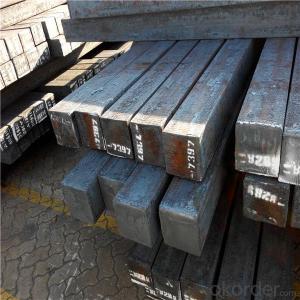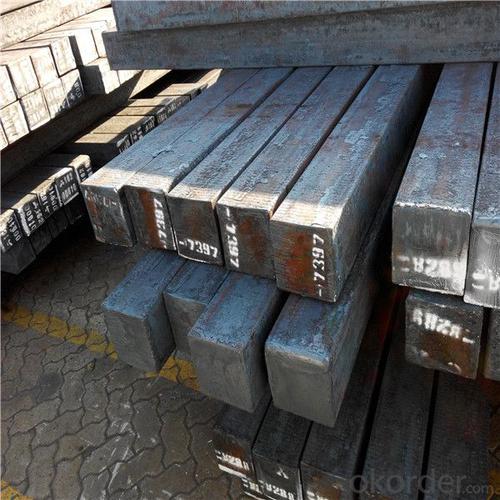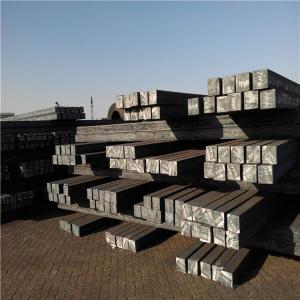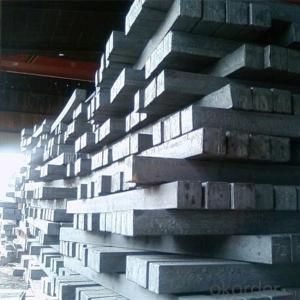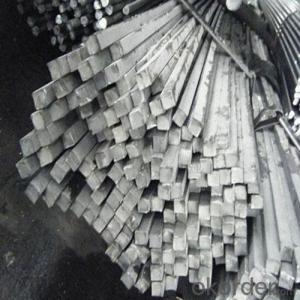Carbon Steel Billets Square Billets hot sale
- Loading Port:
- Tianjin
- Payment Terms:
- TT OR LC
- Min Order Qty:
- 1000 m.t.
- Supply Capability:
- 16250 m.t./month
OKorder Service Pledge
OKorder Financial Service
You Might Also Like
Specification
Billets, or ingots (as they sometimes referred to), are not of practical use until they have been formed
into more functional shapes and sizes. While they have already been put in the furnace, they still require
a series of shaping and molding procedures such as hot and cold working, milling and cutting before they
are sold in hardware stores, or used for different applications. The unformed billets, however, can be used
in striking currency such as coins and as reserves, similar to gold bars.
Gade:
Standard | C(%) | Mn(%) | S(%) | P(%) | Si(%) |
Q195 | ≤0.12 | ≤0.50 | ≤0.040 | ≤0.035 | ≤0.30 |
Q235 | ≤0.20 | ≤1.40 | ≤0.045 | ≤0.045 | ≤0.35 |
Q275 | ≤0.22 | ≤1.50 | ≤0.045 | ≤0.045 | ≤0.35 |
20MnSi | 0.17-0.25 | 1.2-1.6 | ≤ 0.050 | ≤ 0.050 | 0.40-0.80 |
3SP | 0.14-0.22 | 0.40-0.85 | ≤ 0.050 | ≤ 0.040 | 0.05-0.15 |
5SP | 0.28-0.37 | 0.50-1.00 | ≤ 0.050 | ≤ 0.040 | 0.15-0.30 |
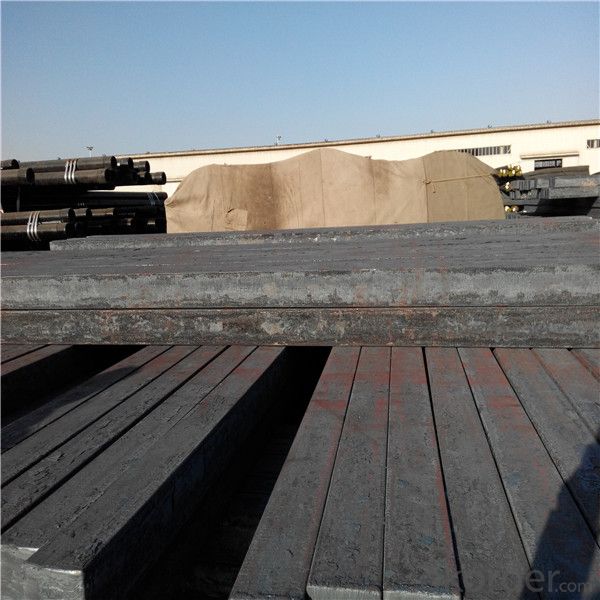
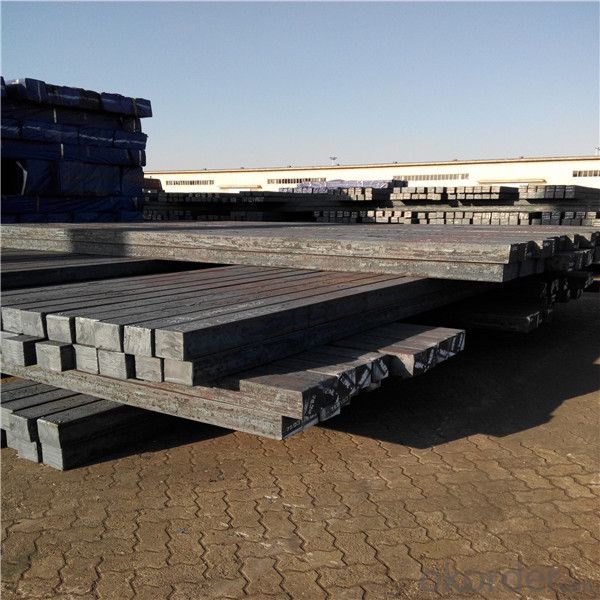
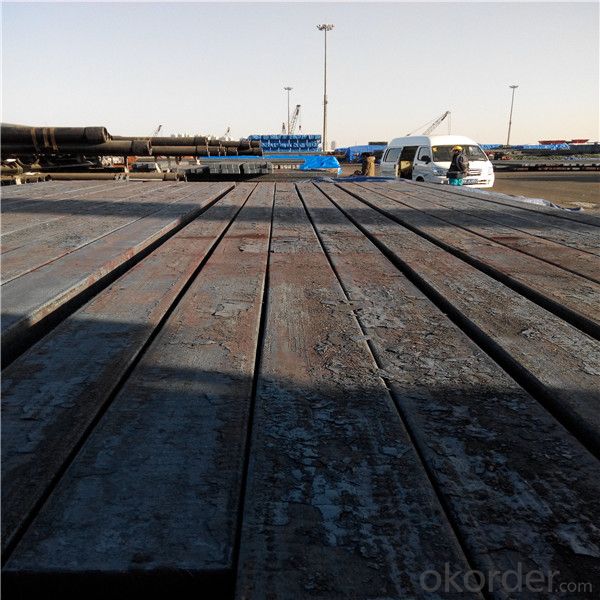
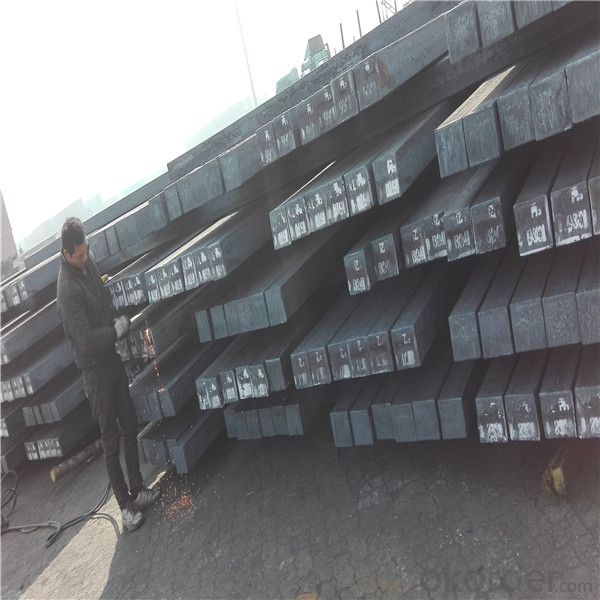
Our service :
We have a plant and professional team to provide our best service, from the start of production until the
loading into the vessel, we have a complete quality follow up procedure, to assure our products arrives to the customer with satisfaction. Welcome new and old customers
to contact us for future business relationships! We will give you a surpise price.
Packing :
Within 30 days
1.Standard export package
2.In bundles with steel strips
3.As the requirements of the customers
FAQ:
Q: What is payment terms?
A: FOB 30% T/T IN ADVANCE AS DEPOSIT AND 70% T/T BEFORE SHIPMENT
CIF and CFR 30% T/T IN ADVANCE AS DEPOSIT AND 70% T/T AS THE COPY OF B/L OR L/C AT SIGHT
Q:How to guarantee the quality of the products?
A:We have established the international advanced quality management system,every link from raw material
to final product we have strict quality test;We resolutely put an end to unqualified products flowing into the market.
At the same time, we will provide necessary follow-up service assurance.
Q:How long can we receive the product after purchase?
A :In the purchase of product within three working days, We will arrange the factory delivery as soon as possible.
The pecific time of receiving is related to the state and position of customers.
- Q: How are steel billets used in the manufacturing of slabs?
- Steel billets are an essential raw material used in the manufacturing of slabs. Slabs are large, flat pieces of steel that are used as a primary input in various industries, such as construction, automotive, and manufacturing. To produce slabs, the first step involves obtaining steel billets. These billets are semi-finished steel products that are typically obtained through the continuous casting process or by hot-rolling ingots. They are solid, rectangular or square-shaped blocks of steel with a cross-sectional area that can vary depending on the desired size and thickness of the slabs. Once the steel billets are obtained, they are heated to a high temperature to make them more malleable and easier to shape. This process, known as hot rolling, involves passing the billets through a series of rolling mills to progressively reduce their thickness and increase their length. The rolling mills apply intense pressure to the billets, causing them to elongate and acquire the desired dimensions. During the hot rolling process, the steel billets are often subjected to various manipulations, such as reheating and cooling, to ensure proper shaping and metallurgical properties. The billets may also go through additional processes, such as descaling (removing the oxide layer) and surface treatment, to enhance their quality and finish. Once the hot rolling process is completed, the steel billets are transformed into slabs. These slabs are then further processed to meet specific requirements. For instance, they may undergo additional rolling or reheating processes to achieve the desired thickness, dimensions, and surface finish. The slabs can also be cut into smaller pieces or further processed into different steel products, such as plates, sheets, or coils, depending on the intended use. In summary, steel billets play a crucial role in the manufacturing of slabs. They serve as the starting point for the production process, undergoing hot rolling and other treatments to transform them into the desired shape, size, and quality. The resulting slabs are then used as a primary input in various industries, contributing to the production of a wide range of steel products.
- Q: What are the challenges faced in the production of steel billets?
- There are several challenges faced in the production of steel billets. Some of the major challenges include ensuring consistent quality and composition of the billets, managing the high temperatures involved in the production process, minimizing energy consumption, and meeting environmental regulations. Additionally, maintaining the proper size and shape of the billets throughout the production process is crucial, as any deviations can lead to subsequent processing issues. Overall, the production of steel billets requires careful monitoring, control, and adherence to strict standards to overcome these challenges.
- Q: What are the different methods of steel billet surface inspection?
- In the industry, various methods are commonly employed for inspecting the surface of steel billets. These techniques aim to identify any flaws or imperfections, guaranteeing the use of high-quality steel in the manufacturing process. 1. Visual inspection: Trained inspectors visually examine the billet's surface for visible defects like cracks, dents, scratches, or irregularities. While a straightforward approach, it serves as a crucial initial step in the inspection process. 2. Magnetic particle inspection: This method involves applying a magnetic field to the billet's surface and then introducing iron particles suspended in liquid. If there are any surface defects or cracks, the iron particles adhere to them, creating a visible indication. This technique is especially effective for detecting surface cracks. 3. Eddy current testing: Employing electromagnetic induction, this method detects surface defects. A probe is passed over the billet's surface, and any changes in electrical conductivity caused by cracks or defects generate eddy currents, which can be identified and analyzed. It is commonly used for detecting surface cracks, but it can also measure coating thickness or identify material property variations. 4. Ultrasonic testing: Ultrasonic waves are utilized to inspect the billet's surface for defects. A transducer sends ultrasonic waves into the material, and any changes in the wave pattern caused by surface defects are detected and analyzed. This method is frequently employed for detecting surface cracks, but it also provides insight into the internal structure of the billet. 5. Dye penetrant inspection: This method involves applying colored dye to the billet's surface, which is then removed, leaving the dye trapped within any defects or cracks. A developer is then applied to enhance the visibility of the dye, facilitating the identification and localization of surface defects. It is particularly effective for detecting small surface cracks. 6. Laser scanning: Laser scanning employs a laser beam to scan the billet's surface and generate a three-dimensional representation. This method is valuable for detecting surface irregularities, measuring dimensions, and creating digital models for further analysis. Each of these methods possesses unique advantages and limitations, often employed in combination to ensure a comprehensive inspection of the steel billet's surface. The choice of inspection method depends on factors such as the targeted defects, billet size and shape, and desired level of accuracy.
- Q: How are steel billets used in the manufacturing of fasteners?
- Steel billets are used in the manufacturing of fasteners as they serve as the raw material for creating a variety of fastener types, including screws, bolts, and nuts. These billets are heated and then forged or rolled into the desired shape and size, forming the base of the fastener. The high strength and durability of steel make it an ideal material for fasteners, ensuring secure and reliable connections in various applications.
- Q: How are steel billets used in the manufacturing of agricultural machinery parts?
- Steel billets are an important raw material in the manufacturing of agricultural machinery parts. These billets are essentially semi-finished steel products that are used as a starting point for various manufacturing processes. Firstly, steel billets are shaped into specific forms using various techniques such as casting, rolling, or extrusion. These processes help transform the solid billets into desired shapes, such as bars, rods, or sheets, which are then used as base materials for agricultural machinery parts. Once the billets are shaped, they are further worked upon through machining, cutting, and welding processes to create specific components for agricultural machinery. For example, billets can be machined into shafts, gears, or axles that are essential for the functioning of these machinery parts. Moreover, the strength and durability of steel billets make them suitable for applications in heavy machinery like tractors, combines, or harvesters. Agricultural machinery parts made from steel billets possess high tensile strength, resistance to wear and tear, and can withstand the demanding conditions encountered in the agricultural sector. In addition, steel billets can be heat-treated to enhance their mechanical properties, such as hardness or toughness, making them more robust and capable of withstanding heavy loads and extreme conditions. This makes them ideal for agricultural machinery parts that often face intense forces during operation. Furthermore, steel billets can be used in the manufacturing of precision components, such as bearings or bushings, which are crucial for smooth and efficient operation of agricultural machinery. The dimensional accuracy and consistency of steel billets ensure that these precision parts fit perfectly and function effectively. Overall, steel billets play a vital role in the manufacturing of agricultural machinery parts. Their versatility, strength, and ability to be shaped and processed make them an essential material in producing components that can withstand the demanding and challenging conditions of the agricultural industry.
- Q: Can steel billets be polished for improved surface finish?
- No, steel billets cannot be polished for improved surface finish as they are usually unfinished or have a rough surface due to the manufacturing process.
- Q: What are the different methods of corrosion protection for steel billets?
- There are various methods available for corrosion protection of steel billets. Some of the common methods include: 1. Coating: Applying a protective coating on the surface of steel billets is one of the most effective methods of corrosion protection. This can be achieved through processes such as hot-dip galvanizing, painting, or applying a protective film. The coating acts as a barrier between the steel surface and corrosive elements in the environment, preventing direct contact and reducing the likelihood of corrosion. 2. Cathodic Protection: This method involves creating an electrochemical reaction to protect the steel billets from corrosion. Cathodic protection can be achieved by either using sacrificial anodes or by applying an impressed current. Sacrificial anodes, typically made of zinc or magnesium, are connected to the steel billets, and they corrode sacrificially instead of the steel, thus protecting it. Impressed current systems use an external power source to provide the necessary current to protect the steel. 3. VCI (Volatile Corrosion Inhibitors): VCI is a method that involves using chemicals that release vapors to create a protective layer on the steel surface. These chemicals inhibit the corrosion process by neutralizing the corrosive agents or forming a protective film on the steel surface. VCI can be applied through various methods, such as coating, wrapping, or inserting VCI paper or packets into the packaging of steel billets. 4. Alloying: Introducing alloying elements into the composition of steel billets can significantly improve their corrosion resistance. For example, adding chromium or nickel can enhance the stainless properties of steel, making it more resistant to corrosion. Alloying can be done during the initial production of steel billets or through post-treatment processes. 5. Environmental Control: Controlling the environment in which steel billets are stored or used is also crucial in preventing corrosion. This includes measures such as maintaining proper humidity levels, avoiding exposure to corrosive chemicals or gases, and minimizing contact with water or moisture. By controlling the environment, the likelihood of corrosion can be reduced, thereby protecting the steel billets. It is important to note that the choice of corrosion protection method depends on various factors, including the anticipated level of exposure to corrosive elements, the intended use of the steel billets, and cost considerations. Therefore, it is advisable to consult with corrosion experts or engineers to select the most suitable method for a particular application.
- Q: How is the quality of steel billets ensured during the manufacturing process?
- The quality of steel billets is ensured during the manufacturing process through various measures such as rigorous inspection and testing procedures. These include visual inspections, dimensional checks, and non-destructive testing techniques like ultrasonic testing or magnetic particle inspection. Additionally, chemical analysis is conducted to verify the composition of the steel billets, ensuring they meet the required specifications. By implementing these quality control measures, any potential defects or inconsistencies can be identified and addressed promptly, ensuring the production of high-quality steel billets.
- Q: What are the main factors affecting the surface quality of steel billets?
- Several factors influence the surface quality of steel billets. Firstly, the cleanliness of the steel is crucial. Impurities like oxides, scale, and inclusions can negatively impact the surface, causing defects such as pits, cracks, and roughness. Secondly, the temperature during the steelmaking process is important. Overheating can result in excessive scaling and oxidation, leading to a poor surface finish. Insufficient heating, on the other hand, can cause a non-uniform surface and inconsistent mechanical properties. Residual stresses also affect the surface quality. Uneven cooling or improper heat treatment can result in surface cracks, warping, or distortion. Surface treatment processes and their effectiveness also impact the surface quality. Grinding, polishing, or shot blasting can improve the surface finish by eliminating defects and creating a smoother surface. The quality of equipment and tools used in steel production plays a significant role as well. Worn-out or poorly maintained machinery can cause surface defects, inadequate surface preparation, or improper handling, thus affecting the final surface quality. Lastly, the composition and microstructure of the steel itself influence the surface quality. Variations in alloying elements, grain size, and phase distribution can affect the surface finish, hardness, and overall quality of the billets. In conclusion, cleanliness, temperature control, residual stresses, surface treatment processes, equipment quality, and steel composition are the main factors that affect the surface quality of steel billets. Proper steelmaking practices, surface treatments, and quality control measures are crucial in achieving high-quality steel billets with superior surface finish.
- Q: What are the different surface defects that can occur during steel billet production?
- During the production of steel billets, a range of surface defects may occur, which can have a detrimental impact on the final product's quality and performance. Some commonly encountered surface defects include: 1. Scale: Formed on the billet's surface due to exposure to high temperatures during heating or rolling, scale is an oxide layer that can impair surface quality and create complications during subsequent processing stages. 2. Cracks: Improper cooling or excessive stress during rolling can cause cracks to develop on the billet's surface. These cracks have the potential to propagate and result in further structural weaknesses, compromising the integrity of the final product. 3. Pitting: The formation of small cavities or depressions on the billet's surface is referred to as pitting. This defect can arise from chemical reactions or exposure to corrosive environments during production or storage. 4. Decarburization: The loss of carbon from the billet's surface, resulting in a reduced carbon content, is known as decarburization. This phenomenon can occur during heating or prolonged exposure to high temperatures, impacting the mechanical properties of the steel. 5. Lamination: Lamination defects arise when layers or sheets of material separate within the billet, leading to weak points in the structure. Improper casting, cooling, or rolling processes can contribute to the occurrence of this defect. 6. Inclusions: Non-metallic particles or impurities that become trapped within the steel matrix during production are referred to as inclusions. These can consist of oxides, sulfides, or other foreign materials, all of which have the potential to weaken the steel and diminish its overall properties. 7. Slivers: Thin strips or elongated pieces of steel that detach from the billet's surface during rolling are known as slivers. These can result in surface roughness and impact the dimensional accuracy of the final product. 8. Seam: A visible line or seam on the billet's surface is indicative of a seam defect, which occurs when the molten steel fails to properly bond during the casting process. This defect can undermine the steel's strength and compromise its structural integrity. To ensure the production of high-quality steel billets, manufacturers employ various techniques, including meticulous control of heating and cooling processes, regular inspection and monitoring, and the utilization of advanced technologies to identify and rectify these surface defects.
Send your message to us
Carbon Steel Billets Square Billets hot sale
- Loading Port:
- Tianjin
- Payment Terms:
- TT OR LC
- Min Order Qty:
- 1000 m.t.
- Supply Capability:
- 16250 m.t./month
OKorder Service Pledge
OKorder Financial Service
Similar products
Hot products
Hot Searches
Related keywords
